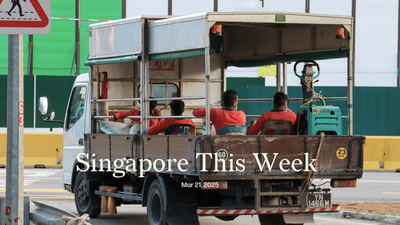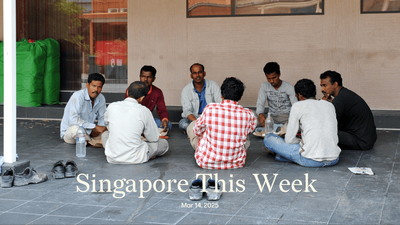Politics: The Rajahs of Ridout
Vivian Balakrishnan, foreign affairs minister, and K Shanmugam, home affairs and law minister, live on some of the biggest properties in Singapore, colonial black-and-whites along Ridout Road, a secluded stretch far from any main road or public transport stop. Balakrishnan’s property, rented in 2019, is 136,101 sq ft (12,664 sq m) big, about one-and-a-half times the size of a football field or equivalent to 140 average public housing flats. (Shanmugam’s, rented in 2018, is thought to be much bigger, though CNA said precise data is unavailable.) The Singapore Land Authority (SLA) was forced to disclose this following a series of provocative posts by Kenneth Jeyaretnam, leader of the Reform Party, in which he questioned the fairness and transparency of the auction process. SLA, an agency under Shanmugam’s Ministry of Law, manages 262 of these bungalows. It said that the two ministers had bid above the “guide rent” for the properties, that the rentals were “performed in full compliance with the relevant SLA procedures”, and that more will be disclosed in Parliament in July. Since the government only maintains public data on these transactions for the past six months, it’s unclear if the guide rents here are artificially low compared with the property value, as some critics suggest. For the ruling People’s Action Party (PAP), coming at a time when many Singaporeans feel priced out of a red-hot property market, and when many are questioning the city’s gross wealth inequalities, this is a public relations nightmare. The SLA confirmed that both properties had been untenanted for years before Balakrishnan and Shanmugam snapped them up. PAP fans have latched onto this as justification for their leaders’ actions—sacrificially helping out state coffers by renting unwanted properties. Yet this fact actually speaks to another inconvenient reality—that the only people with the wherewithal and desire to live in these colonial mansions are PAP ministers. Take a bow, the Rajahs of Ridout.
Society: Slurping slurries to beat the heat
It’s too darn hot! And to help deal with heat strain and exhaustion, while improving heat tolerance, 200 construction workers drank ice slurries last July, as part of a trial led by the Ministry of Manpower’s Workplace Safety and Health Institute. Slurry lowers the core body temperature (that of the internal organs), preventing heat-related illnesses that can cause fatigue, injuries and even death. The workers said they felt “cooler, better hydrated and more energetic.” Workplace safety has been a hot button issue in Singapore in recent years. In 2022, workplace-related deaths, dangerous occurrences and cases of occupational diseases rose across the board. Fatalities increased from 37 in 2021 to 46 last year—a rate of 1.3 per 100,000 workers. Falls from a height and vehicular incidents accounted for half of the deaths; most of which occurred in the construction sector. So it’s not enough to just pump workers with brain-numbing, frozen drinks. Construction sites can also enforce more breaks under the shade, provide better quality uniforms that are breathable and ultraviolet-protective, as well as educate workers in their native languages about heat stress. But like many measures that could improve the health, safety and welfare of workers (like banning the use of lorries) companies have cited high costs and manpower constraints as hurdles to implementing them. Seems like more hot air and cold comfort to workers.
Society: Reading is fundamental
Singaporean kids came out on top again, scoring a mean of 587 in the Progress in International Reading Literacy Study (PIRLS) 2021, whose results were just announced. 6,719 randomly selected primary four students across all 183 primary schools in Singapore participated in the study in late 2020. They outperformed Ireland (577), Hong Kong (573) and Russia (567). According to the Ministry of Education (MOE), Singapore is the only country that has made steady progress since PIRLS was first conducted two decades ago. Our scores are particularly impressive considering the disruption caused by the pandemic, and MOE attributes them to “refinements made to our English Language teaching and learning curriculum”, as well as “programmes in place to help students who need additional literacy support.” Encouragingly, the reading performance gap between children from lower and higher socioeconomic backgrounds hasn’t widened in the last five years. But despite their stellar results, fewer Singaporean children are finding joy in reading. The number who “enjoy[ed] reading a lot” fell to 51 percent, the lowest in a decade. Some chalk this up to the TikTok-ification of attention spans, where “iPad kids” are so used to short, sensational content they no longer have the patience to read. But social media and books aren’t necessarily in opposition to each other. #BookTok, a hashtag used on TikTok to share book recommendations, has raked up millions of views. Many Singaporean bookstores, including Times and Popular, now have entire sections dedicated to BookTok recommendations. Moreover, even the kids’ parents are affected—only 48 percent “enjoyed reading a lot” in 2021, down from 60 percent in 2011. If “building a strong culture of reading takes a whole-of-society effort,” as MOE’s director-general of education said, maybe it’s time we all picked up a book.
Arts: The ArtsEquator Fellowship
ArtsEquator has launched a new six-month fellowship, with a S$5,000 stipend, for mid-career arts critics and journalists in South-east Asia. For this 2023/2024 cycle, the fellowship is only open to those focusing on theatre, dance, and film in the region. Interestingly enough, ArtsEquator will not publish these reviews. Instead, the stipend is meant to support criticism that will be published on other platforms, like personal newsletters and blogs, podcasts, and even other arts websites and publications. Given the relatively low contributor rates regionally, especially outside of Singapore, this initiative will likely support criticism work that wouldn’t have otherwise been financially viable. This announcement comes months after ArtsEquator broke the news about it ceasing regular publication of articles on its website. From its inception in 2016, ArtsEquator had been one of the primary online destinations for arts media in South-east Asia. The fellowship, it said, marks a new direction for the organisation, as it will now focus on “programme and grant-giving platforms” in order to cultivate arts criticism in the region. Applications are open, and close on June 30th. Find more information on the ArtsEquator website.
Arts: Cultural Extravaganza by the Singapore Chinese Cultural Centre
The Singapore Chinese Cultural Centre (SCCC) is presenting its annual Cultural Extravaganza programme this month. Titled “(Re)presenting Culture Across Every Generation”, the 2023 festival features Singaporean Chinese art and cultural groups and will spotlight the cross-generational potential of traditional arts. Nam Hwa Opera’s “Who Says It First” is the Teochew opera academy’s first attempt at a “modern Mandopop musical”. The performance will retain traditional elements of Teochew opera and is set in the modern era focusing on the life of a nuclear family dealing with the consequences of dementia. “Intimate Intricacies” is a concert by Ding Yi Music Company that will spotlight two disappearing Chinese handicrafts—giant joss stick making and Teochew embroidery—through the lens of Chinese chamber music. The concert features work by two young local composers, Jon Lin Chua and Liong Kit Yeng, as well as footage from the Eng Tiang Huat Chinese Cultural Shop in Geylang and the Tay Guan Heng Joss Stick Manufacturer, which closed last December after almost 90 years in business. For more information on Cultural Extravaganza, including information about all 11 programmes and ticketing details, please visit SCCC’s website.
History weekly by Faris Joraimi
Leon Comber died late last week, aged 101. The notable author—of more than 50 works on Malayan topics ranging from Chinese culture to military history—saw combat in India, Burma and Malaya during the second world war, before serving in the colonial police. Between 1949 and 1956, Comber was an officer in the British Special Branch, the colonial government’s intelligence agency whose task was to monitor the activities of suspected dissidents, and back then especially, communists. Ironically this was also when he married one of Malaya’s most eloquent critics of British imperialism, Han Suyin, in 1952. In her novel And the Rain My Drink, the Chinese Eurasian doctor who then lived in Johor Bahru with Comber described how ordinary people lived in constant fear during the Malayan Emergency, caught between the jungle and the colonial police. Civilians weren’t spared harsh British control and surveillance: rural Chinese were forcibly relocated to barbed-wire-fenced “New Villages”, while in cities like Singapore, suspected communist “sympathisers” were rounded up, tortured and detained. Backstabbing and double-crossing was rife. For the communist guerillas, they felt part of a global Afro-Asian struggle for freedom; the British mirrored this, importing the repressive methods they used in Palestine to Malaya, and later applying those lessons to the Mau Mau Rebellion in Kenya. So much for a “peaceful” independence. In 1956 Comber resigned, protesting the authorities’ attempt to have publishers withdraw Han’s novel. He nevertheless disagreed with the novel’s contents, and their marriage ended in 1958. Comber went on to help Merdeka leader David Marshall at his Meet-the-People sessions, before joining the Eastern University Press. He belongs to that last generation of British scholar-administrators who came “out East” on service before settling into a leisurely life of prolific local scholarship.
Tech: The Basis of allegations
Basis AI is the latest tech start-up embroiled in co-founder drama. It centres on the fact that Liu Feng Yuan, co-founder and then CEO, also had an advisory role at SPH Media, through which he allegedly poached Basis AI staff, following the acquisition of the firm by Aicadium, a Temasek subsidiary. This, said Tech in Asia, was “part of a post-merger exodus that involved at least 10 of the 15 original data science and engineering employees.” Liu sought to clarify his actions, highlighting that his advisory role at SPH Media was unpaid and approved by Aicadium. However, co-founder Silvanus Lee’s subsequent statement on LinkedIn revealed that, in addition to his technical advisor position, Liu was in discussions for an executive role at SPH Media; and that he may have been disciplined by Aicadium for his actions. The statements provided by both Liu and Lee underscore the complexity of navigating the post-acquisition landscape, where the co-founders’ priorities may appear to be conflicting. Balancing personal ambitions with the acquired company’s best interests, especially in terms of employee retention and overall stability, remains a challenge that requires careful analysis and understanding. With their stellar profiles in tech and civil service, both Liu and Lee will continue to be closely watched as this situation unfolds.
Tech: TikTok your way into tech
Even as it faces accusations of spying, algorithmic manipulation and inadequate content moderation in the US, TikTok is eager to train young Singaporeans in its ways. The newly launched TikTok Tech Immersion programme plans to support 5,000 tertiary students by providing them comprehensive academic and practical tech training to prepare them for careers in the ever-evolving tech industry. The programme will focus on areas such as coding languages, tech architecture, server management, quality assurance, and site reliability. This initiative was announced shortly after Lawrence Wong, deputy prime minister, emphasised Singapore’s strategic focus on developing domestic tech talent at a recent Singapore Computer Society dinner. The country aims to achieve average growth of 5-7 percent in specific tech areas between 2021 and 2025, a drive which is expected to generate around 80,000 well-paying jobs. Singapore’s higher education institutes have increased their intake of Information and Digital Technology courses by nearly a third over the past five years, resulting in more than 8,000 students being trained to enter the tech sector annually. While these corporate training initiatives will help Singapore develop local tech talent for the future, they are small consolation for tech companies today facing an acute shortage of skilled talent.
If you enjoy Jom’s work, do get a paid subscription today to support independent journalism in Singapore.








